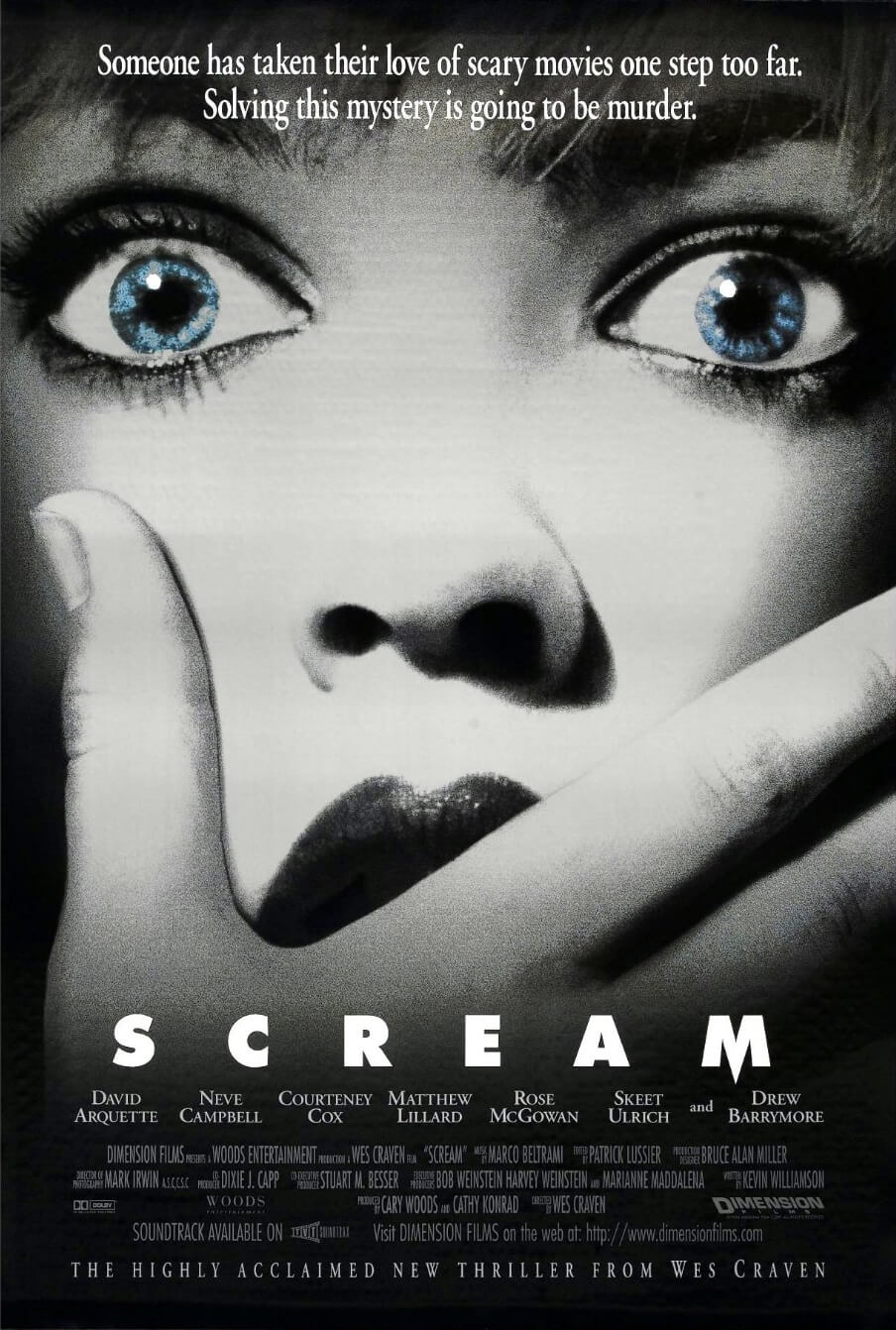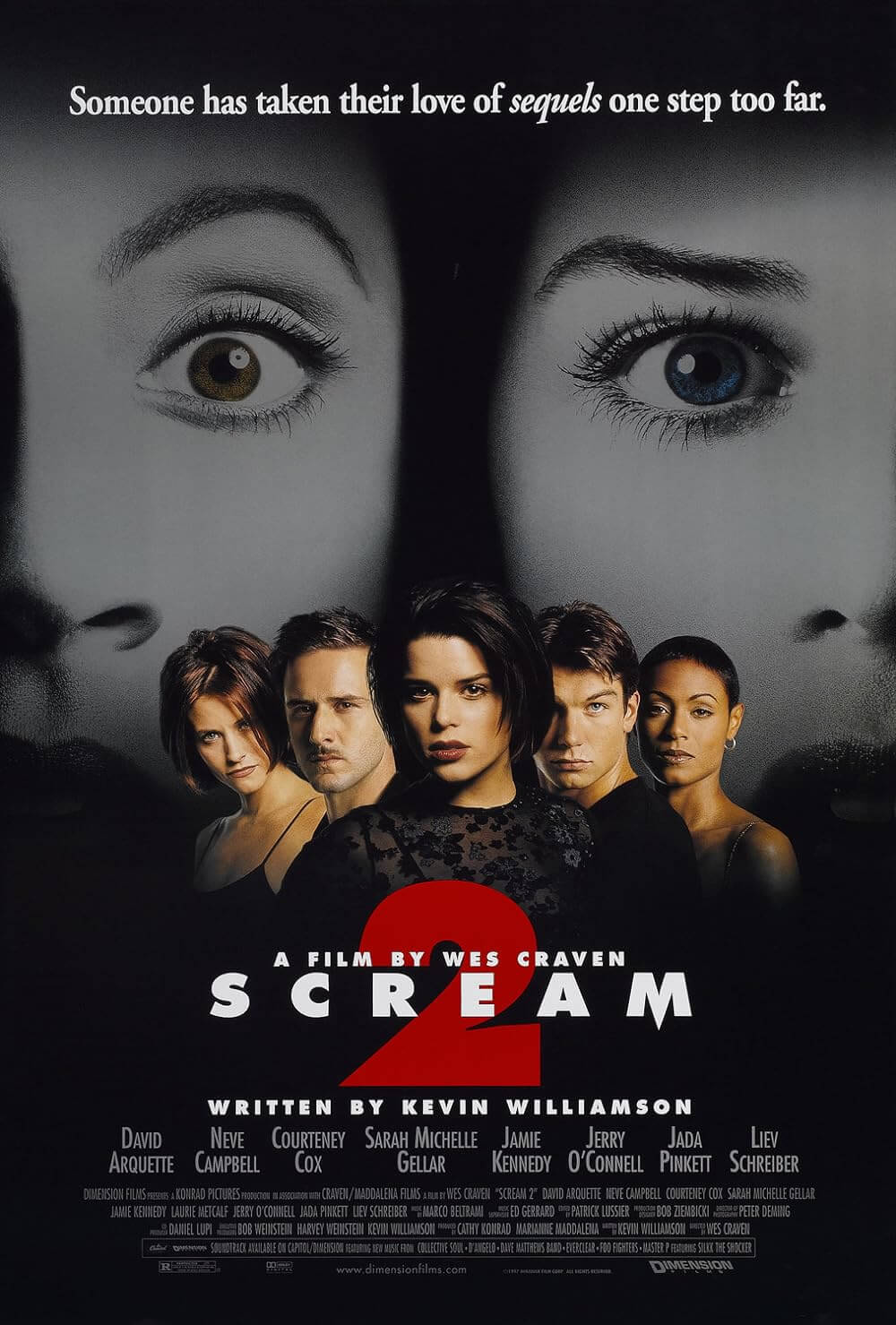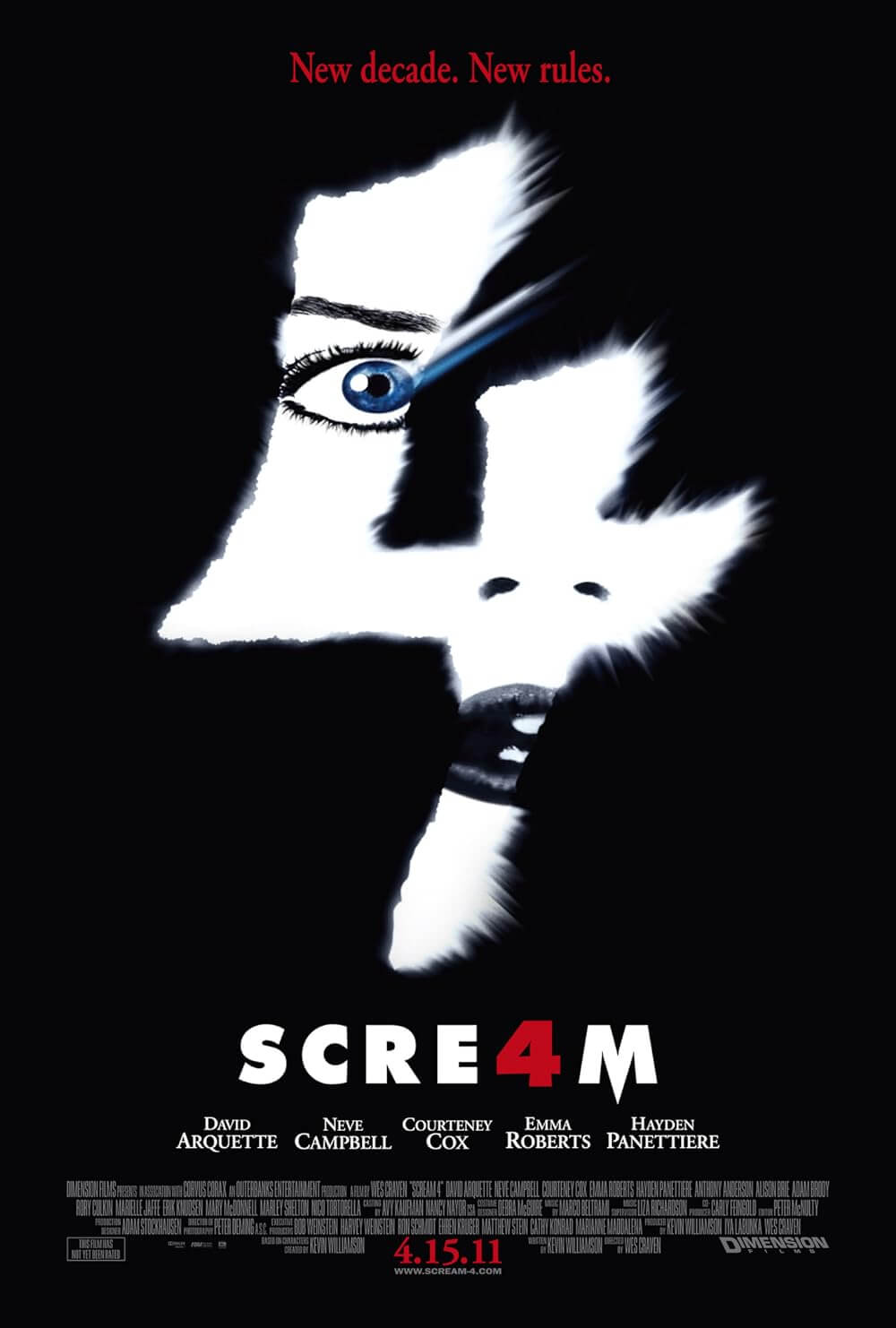
Scream VI
By Brian Eggert |
(Note: Although this review of Scream VI does not reveal any secret identities, it discusses some very mild spoilers and plot points. Consider yourself alerted.)
Whether you call it a legacy sequel, Screamake, or shriekquel, 2022’s Scream rethought the slasher franchise for a new generation while revisiting beloved characters from earlier movies. But it spent too little time establishing the new blood and gave the original characters (Neve Campbell, David Arquette, and Courteney Cox) too little to do—aside from getting in the way and, in one case, perishing in an ugly scene. As a result, everyone onscreen felt underserviced. New series directors Matt Bettinelli-Olpin and Tyler Gillett (Ready or Not, 2019) divided their mostly humorless, self-described “requel” between two sets of characters and, in a way, two separate franchises with distinct tonal and visual approaches. The original group, usually situated in the horror-comedy environs of Scream 1-4, seemed out of place amid the new friend group’s severe but still meta surroundings. The movie and its two sets of characters would have been better serviced by omitting the legacy characters altogether. I mention all this because Scream VI, besides making the transition from Arabic to Roman numerals—if only to turn the last two-thirds of the “M” into a six on marketing materials—concentrates its attention on the new characters. The result is a more focused, scarier, grislier, and more satisfying sequel than its immediate predecessor.
Scream VI doesn’t altogether omit the legacy characters. Returning screenwriters James Vanderbilt and Guy Busick include reporter Gale Weathers (Cox) in a peripheral role. But Sidney Prescott remains offscreen (reportedly due to the producers not wanting to pay Campbell her deserved asking price), written out with a line of dialogue. But most of the 123-minute runtime centers on the new friend group, and the writers explore them with enough depth and spirit to shake off any need of the former cast. Whereas Sidney, Dewey, and Gale remained the survivors for the first four movies—and the sequels worked partly because we enjoyed seeing them back together—Scream VI establishes a new “Core Four.” At the forefront, there’s Sam Carpenter (Melissa Barrera), the secret daughter of one of the original killers, Billy Loomis (Skeet Ulrich), whom she sees in hallucinations. Sam’s younger sibling Tara (Jenna Ortega) now attends college in New York City, and her protective sister has tagged along. So have Mindy (Jasmin Savoy Brown) and her twin brother Chad (Mason Gooding), who share an uncle in the late Randy, Jamie Kennedy’s movie-savvy nerd from the original trilogy. Given the college setting, the film quickly points out its parallels to Scream 2 (1997), complete with a campus backdrop and a higher body count. Once the killing starts, Mindy, the resident horror buff, calls their predicament “a sequel to the requel.”
 But before that, Scream VI boasts a memorable opener—usually the best part of any Scream movie. Samara Weaving plays an associate professor in film studies, teaching about slasher movies no less, and awaits a rendezvous with a guy from a dating app. He’s lost, and by asking for help, he lures her outside and, well, you can guess what happens. Except, you can’t predict the imaginative twist early on that terrifically breaks the mold of previous openers. Without giving away what happens, the message is this: “Who gives a fuck about movies?” Indeed, the writers seem less concerned about following genre clichés at this point. After all, there aren’t a lot of common themes among Part 6s, aside from being cash grabs. Although there’s an obligatory scene where Mindy points out that the rules have changed because “We’re in a franchise,” it’s an observation that feels like it’s two movies too late. Scream 4 (2011), particularly the opening scene, already explored the ups and downs of franchises, and the commentary here is less about pointing out trends in horror than setting expectations for what will happen in the remaining screen time. Still, Mindy’s speech allows the filmmakers to acknowledge that their franchise exists to perpetuate an intellectual property. Therefore, it’s less about loyalties to specific characters than sustaining a brand until the next sequel hits theaters, which means anyone can die.
But before that, Scream VI boasts a memorable opener—usually the best part of any Scream movie. Samara Weaving plays an associate professor in film studies, teaching about slasher movies no less, and awaits a rendezvous with a guy from a dating app. He’s lost, and by asking for help, he lures her outside and, well, you can guess what happens. Except, you can’t predict the imaginative twist early on that terrifically breaks the mold of previous openers. Without giving away what happens, the message is this: “Who gives a fuck about movies?” Indeed, the writers seem less concerned about following genre clichés at this point. After all, there aren’t a lot of common themes among Part 6s, aside from being cash grabs. Although there’s an obligatory scene where Mindy points out that the rules have changed because “We’re in a franchise,” it’s an observation that feels like it’s two movies too late. Scream 4 (2011), particularly the opening scene, already explored the ups and downs of franchises, and the commentary here is less about pointing out trends in horror than setting expectations for what will happen in the remaining screen time. Still, Mindy’s speech allows the filmmakers to acknowledge that their franchise exists to perpetuate an intellectual property. Therefore, it’s less about loyalties to specific characters than sustaining a brand until the next sequel hits theaters, which means anyone can die.
After all, legacy sequels exist foremost to sustain a brand. In that effort, Bettinelli-Olpin and Gillett’s new Scream movies clearly borrow from the example of David Gordon Green’s recently completed Halloween trilogy (2018, 2019, 2022). Fortunately, Scream VI is better than those movies and, miraculously, avoids feeling like fan fiction for the most part. Still, much like Green’s version of the Michael Myers mask, Ghostface’s mask appears cracked and worn here, suggesting it’s the original from 1996. With that in mind, the script sharpens the whodunit aspect of the series, relying less on cinephilia and post-modern discussions about the Stab franchise—which reached its zenith in Scream 4—and instead concentrates on developing characters, building suspense through a procession of gory kills, and crafting a worthy mystery. Besides the impressive opener, the killer’s conceit this time proves intriguing: The weathered mask suggests the culprit goes back to the original and, at the location of each new killing, this Ghostface leaves a mask that belonged to a former killer from an earlier Scream movie. How did the killer acquire these masks? Why does the villain leave them in reverse chronological order? And what happens to Sam, whose disturbed mind is plagued by her murderous father, when Billy’s mask arrives on the scene? These questions permeate the scenario and drive the story forward.
Perhaps best of all, Scream VI spends ample time with the “Core Four” to establish a new set of survivors, whose bond proves endearing through the movie’s various conflicts. Besides the whole masked killer problem, online rumors claiming that Sam framed Richie (Jack Quaid) and Amber (Mikey Madison), the killers from 2022’s Scream, cast doubt about Sam’s sanity. Her case isn’t helped when she frightens off her therapist (Henry Czerny) and admits to needing antipsychotic medication to prevent her from seeing hallucinations of her father. And while Sam dwells on her traumatic past and family line, Tara embraces campus life and parties recklessly, ignoring what happened a year ago and wishing her older sister would stop being so overprotective. Additionally, our heroes have romantic interests and roommates who remain suspicious because, as ever, everyone’s a suspect. Tara shares an apartment with Quinn (Liana Liberato), whose sex-positive antics mean her bedroom door is usually shut. By contrast, Chad shares his room with the virginal Ethan (Jack Champion, the sole human from Avatar: The Way of Water). Mindy has been seeing Anika (Devyn Nekoda), and Sam has a beau (Josh Segarra) she keeps secret. Quinn’s dad, Detective Bailey (Dermot Mulroney), plays the lead in the new Ghostface case, and he’s joined by someone familiar now working for the FBI.
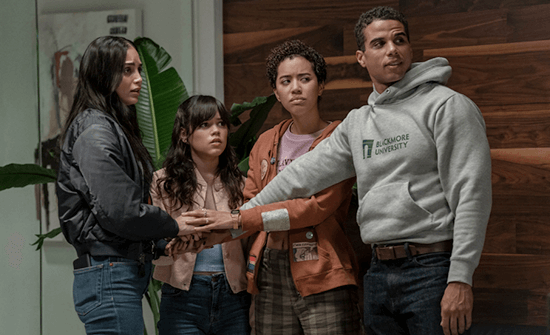 The filmmakers smartly set Scream VI around Halloween, where every third person on the street or subway wears a Ghostface costume (in rather poor taste, given the continuing real-life murders that inspire the Stab franchise-within-a-franchise), allowing the killer to hide in plain sight and cause rampant paranoia. Cinematographer Brett Jutkiewicz returns for attractive on-location shooting, with Montreal playing New York, and composers Brian Tyler and Sven Faulconer (who borrow from James Horner’s score for 1985’s Aliens in a climactic scene to rousing effect) amplify the scares. The filmmakers also concoct several high-tension sequences of terror and don’t skimp on the practical gore, prompting several audible gasps during my screening (including my own). The sheer viscerality is impossible to deny, leading to some of the goriest shots in any Scream movie. A breathless scene on a ladder is a highlight, along with brutal subway and bodega attacks, and a nimble sequence in Gale’s apartment that will have you shifting back and forth in your seat, dodging phantom knife thrusts. But small gaps in logic arise. Note how, at various points in the movie, Ghostface’s would-be victims pummel the killer’s head with a knife block, cast-iron pan, and vase. Shouldn’t the culprit have bruises or marks to show for this? In any case, the particularly Wes Craven-esque finale finds our survivors planning to fight back (think of Craven’s The Hills Have Eyes or A Nightmare on Elm Street), leading to the inevitable Scooby-Doo reveal—a distractingly performed, over-the-top scene that took me out of the movie.
The filmmakers smartly set Scream VI around Halloween, where every third person on the street or subway wears a Ghostface costume (in rather poor taste, given the continuing real-life murders that inspire the Stab franchise-within-a-franchise), allowing the killer to hide in plain sight and cause rampant paranoia. Cinematographer Brett Jutkiewicz returns for attractive on-location shooting, with Montreal playing New York, and composers Brian Tyler and Sven Faulconer (who borrow from James Horner’s score for 1985’s Aliens in a climactic scene to rousing effect) amplify the scares. The filmmakers also concoct several high-tension sequences of terror and don’t skimp on the practical gore, prompting several audible gasps during my screening (including my own). The sheer viscerality is impossible to deny, leading to some of the goriest shots in any Scream movie. A breathless scene on a ladder is a highlight, along with brutal subway and bodega attacks, and a nimble sequence in Gale’s apartment that will have you shifting back and forth in your seat, dodging phantom knife thrusts. But small gaps in logic arise. Note how, at various points in the movie, Ghostface’s would-be victims pummel the killer’s head with a knife block, cast-iron pan, and vase. Shouldn’t the culprit have bruises or marks to show for this? In any case, the particularly Wes Craven-esque finale finds our survivors planning to fight back (think of Craven’s The Hills Have Eyes or A Nightmare on Elm Street), leading to the inevitable Scooby-Doo reveal—a distractingly performed, over-the-top scene that took me out of the movie.
If the climax registers as hokey and somewhat underwhelms, the prospect of another sequel with this cast and crew is welcome. Scream VI isn’t as funny as the original four but certainly not as humorless as 2022’s Scream. To be sure, the new movie’s primary agenda seems to be delivering slasher thrills, and to that extent, it’s less dependent on clever, self-reflexive conversations about how the unfolding events reflect trends in horror movies. And while the plot references previous installments, it never loses the audience in a black hole of self-awareness. As a result, the proceedings feel more immediate—rooted in scares and whodunit twists rather than various dramatic ironies. Bettinelli-Olpin and Gillett, unhindered by the awkward division of character groups, have started to shed the old skin and refreshingly come into their own. The viewer can enjoy a straightforward slasher instead of getting tangled in self-referential knots or feeling disappointed by an underserviced cast. Accordingly, Barrera and Ortega have more to do here, as do Brown and Gooding, and the bonds within their group are infectious. Indeed, most of all, Scream VI works because its “Core Four” share a dynamic that comes alive, and from them, everything else falls into place.
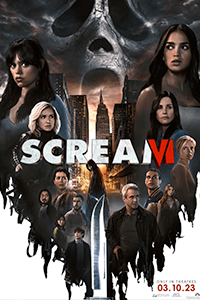
Thank You for Supporting Independent Film Criticism
If the work on DFR has added something meaningful to your love of movies, please consider supporting it.
Here are a few ways to show your support: make a one-time donation, join DFR’s Patreon for access to exclusive writing, or show your support in other ways.
Your contribution helps keep this site running independently. However you choose to support the site, please know that it’s appreciated.
Thank you for reading, and for making this work possible.
Brian Eggert | Critic, Founder
Deep Focus Review


